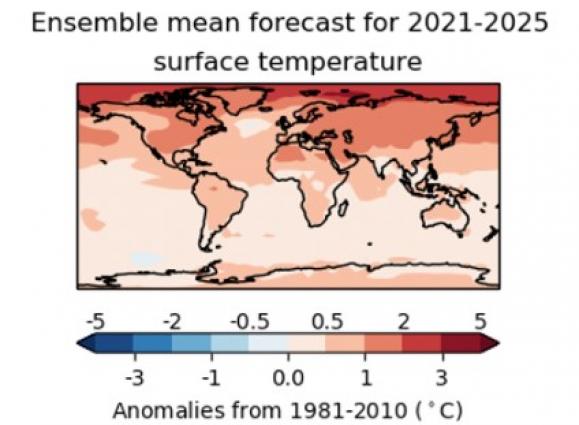
The goal of the Paris climate accord that was signed in 2016 was to keep the rise in global average temperature to well below 2 °C (3.6 °F) above pre-industrial levels; and to pursue efforts to limit the increase to 1.5 °C. A new climate update issued by the World Meteorological Organization (WMO) reveals that there is about a 40% chance of the annual average global temperature temporarily reaching 1.5°C above the pre industrial levels in at least one of the next five years – and these odds are increasing with time.
Quick Summary of the new report
Latest predictions suggest that:
- Annual mean global (land and sea) mean near-surface temperature is likely to be at least 1°C warmer than preindustrial levels (defined as the 1850-1900 average) in each of the coming 5 years and is very likely to be within the range 0.9 – 1.8°C
- It is about as likely as not (40% chance) that one of the next 5 years will be at least 1.5°C warmer than preindustrial levels and the chance is increasing with time
- It is very unlikely (10%) that the 5 year mean annual global near-surface temperature for 2021-2025 will be 1.5°C warmer than preindustrial levels
- The chance of at least one year exceeding the current warmest year, 2016, in the next five years is 90%
- Over 2021-2025, almost all regions, except parts of the southern oceans and the North Atlantic are likely to be warmer than the recent past (defined as the 1981-2010 average)
- Over 2021-2025, high latitude regions and the Sahel are likely to be wetter than the recent past
- Over 2021-2025 there is an increased chance of more tropical cyclones in the Atlantic compared to the recent past
- In 2021, large land areas in the Northern Hemisphere are likely to be over 0.8°C warmer than the recent past
- In 2021, the Arctic (north of 60°N) is likely to have warmed by more than twice as much as the global mean compared to the recent past
- In 2021, southwestern North America is likely to be drier than the recent past whereas the Sahel region and Australia are likely to be wetter

Comments
“These are more than just statistics, Increasing temperatures mean more melting ice, higher sea levels, more heatwaves and other extreme weather, and greater impacts on food security, health, the environment and sustainable development,”
“This study shows – with a high level of scientific skill – that we are getting measurably and inexorably closer to the lower target of the Paris Agreement on Climate Change. It is yet another wakeup call that the world needs to fast-track commitments to slash greenhouse gas emissions and achieve carbon neutrality, Technological advances now make it possible to track greenhouse gas emissions back to their sources as a means of precisely targeting reduction efforts,”
“It is also underlines the need for climate adaptation. Only half of 193 WMO Members have state of the art early warning services. Countries should continue to develop the services that will be needed to support adaptation in climate-sensitive sectors – such as health, water, agriculture and renewable energy – and promote early warning systems that reduce the adverse impacts of extreme events. Besides limitations in early warning services we are having severe gaps in weather observations especially in Africa and island states. This has a major negative impact on the accuracy if the early warnings in those areas and globally. We need to invest in the basic networks as well.”
WMO Secretary-General Prof. Petteri Taalas
Implications
The year 2021, and the crucial climate change negotiations, COP26, in November, have been widely described as a “make-or-break” chance to prevent climate change spiralling ever more out of control. Tackling climate change is high on the agenda of the G-7 Leaders Summit hosted by the United Kingdom from 11-13 June.
